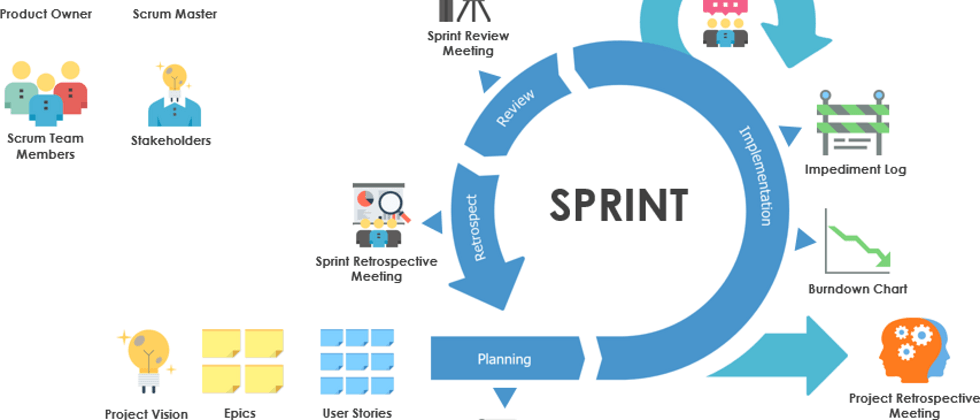This article briefly introduces the Scrum framework . Scrum is an iterative and incremental software development method. There are three main roles : product owner , Scrum Master and Scrum team . Scrum projects usually consist of multiple sprints , each sprint usually lasts 2 to 4 weeks. The key elements of Scrum are: Scrum roles, artifacts, and rituals, and some guidelines and rules.
To start a Scrum project, the product owner creates a product backlog list and determines its priority. Through the Sprint Planning Meeting , the Scrum team decides how many backlog items can be developed in the Sprint. Every day of the Sprint, the team will get together to make a station Daily Scrum Meeting will . During the Sprint, the Scrum Master tries to remove any obstacles and obstacles so that the Scrum team can continue to work. At the end of the Sprint, the team presents the developed features to the team and other stakeholders, and these features may be candidates for release. At the end of Sprint, in review meeting there is a Sprint Review . []( https://www.visual-paradigm.com/scrum/what-is-sprint-retrospective-meeting/)
Scrum Sprint Cycle 8 Steps
The best Scrum software every project needs
A powerful Scrum software that supports Scrum project management. It has Scrum tools such as user story map, product backlog management, sprint backlog management, task management, daily Scrum meetings, sprint planning tools, sprint review tools, sprint review tools, burnout, obstacles, stakeholders And team management.
Scrum roles:
- Product owner
- Scrum master
- Development team
- Stakeholders
Scrum artifact
- Product backlog
- sprint target
- Sprint backlog
Scrum ceremony
- Product to-do list refinement meeting
- Sprint planning meeting
- Daily standup meeting
- Sprint review
- Sprint review
Scrum process explained
- We first need to determine a Product Backlog (a list of product requirements sorted by priority), which is the responsibility of the Product Owner
- The Scrum team estimates and schedules the workload based on the Product Backlog list in the Product Backlog Refinement Meeting
- With the Product Backlog list, we need to hold a Sprint Planning Meeting to define the sprint goal of this iteration (a Sprint time period is usually 1 to 4 weeks), and then select a user story list to form a Sprint Backlog that can achieve the sprint goal The upcoming sprint.
- The Sprint Backlog is completed by the Scrum Team, and each member is refined into smaller tasks according to the Sprint Backlog (the workload of each task can be completed within a few days)
- In the Sprint, daily Scrum meetings need to be held, and the time for each meeting is limited to approximately 15 minutes. Everyone has to speak, interact with all members face to face, report on what they did yesterday and what to accomplish today, and you can ask questions about obstacles or problems that cannot be solved. Then, update your Sprint burndown chart.
- To achieve daily integration, that is, there must be a version that can be successfully compiled and demonstrated every day; many people may not have used automated daily integration. If it passes, the unit test code is executed immediately. If all of these pass, the version is released.
- When all user stories are completed, that is, the Sprint Backlog is completed, it means that a Sprint is completed. At this time, we need to conduct a Sprint Review Meeting (also called a review meeting). Product owners and customers must participate. Every member of the Scrum team will show them the software they have completed. This meeting is very important and cannot be cancelled.
- Finally, the Sprint Retrospective is held after the sprint retrospective at the end of each sprint. During the review process, the team self-identified the process elements that were effective or ineffective during the sprint, as well as potential solutions. Retrospectives usually last 90 minutes and help us integrate continuous improvement into our team culture and Sprint rhythm.
Generalize
Scrum is an iterative and incremental framework for managing product development. It defines a flexible, holistic product development strategy in which development teams work closely together to achieve common goals. It enables the team to self-organize by encouraging the physical co-location or close online collaboration of all team members, as well as daily face-to-face communication between all team members and related disciplines.




**粗体** _斜体_ [链接](http://example.com) `代码` - 列表 > 引用。你还可以使用@来通知其他用户。